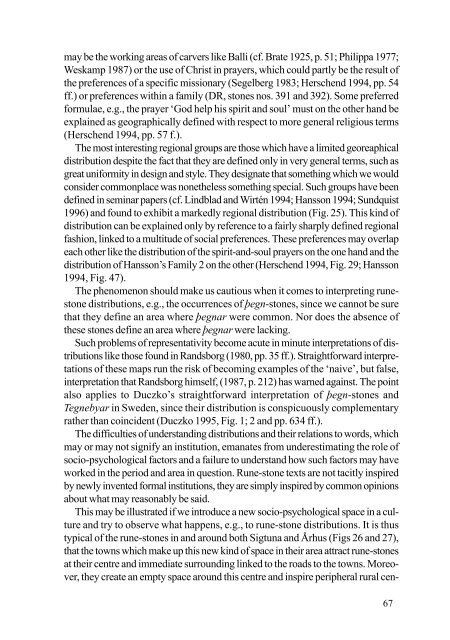Beowulf - Institutionen för arkeologi och antik historia
Beowulf - Institutionen för arkeologi och antik historia
Beowulf - Institutionen för arkeologi och antik historia
Create successful ePaper yourself
Turn your PDF publications into a flip-book with our unique Google optimized e-Paper software.
may be the working areas of carvers like Balli (cf. Brate 1925, p. 51; Philippa 1977;<br />
Weskamp 1987) or the use of Christ in prayers, which could partly be the result of<br />
the preferences of a specific missionary (Segelberg 1983; Herschend 1994, pp. 54<br />
ff.) or preferences within a family (DR, stones nos. 391 and 392). Some preferred<br />
formulae, e.g., the prayer ‘God help his spirit and soul’ must on the other hand be<br />
explained as geographically defined with respect to more general religious terms<br />
(Herschend 1994, pp. 57 f.).<br />
The most interesting regional groups are those which have a limited georeaphical<br />
distribution despite the fact that they are defined only in very general terms, such as<br />
great uniformity in design and style. They designate that something which we would<br />
consider commonplace was nonetheless something special. Such groups have been<br />
defined in seminar papers (cf. Lindblad and Wirtén 1994; Hansson 1994; Sundquist<br />
1996) and found to exhibit a markedly regional distribution (Fig. 25). This kind of<br />
distribution can be explained only by reference to a fairly sharply defined regional<br />
fashion, linked to a multitude of social preferences. These preferences may overlap<br />
each other like the distribution of the spirit-and-soul prayers on the one hand and the<br />
distribution of Hansson’s Family 2 on the other (Herschend 1994, Fig. 29; Hansson<br />
1994, Fig. 47).<br />
The phenomenon should make us cautious when it comes to interpreting runestone<br />
distributions, e.g., the occurrences of þegn-stones, since we cannot be sure<br />
that they define an area where þegnar were common. Nor does the absence of<br />
these stones define an area where þegnar were lacking.<br />
Such problems of representativity become acute in minute interpretations of distributions<br />
like those found in Randsborg (1980, pp. 35 ff.). Straightforward interpretations<br />
of these maps run the risk of becoming examples of the ‘naive’, but false,<br />
interpretation that Randsborg himself, (1987, p. 212) has warned against. The point<br />
also applies to Duczko’s straightforward interpretation of þegn-stones and<br />
Tegnebyar in Sweden, since their distribution is conspicuously complementary<br />
rather than coincident (Duczko 1995, Fig. 1; 2 and pp. 634 ff.).<br />
The difficulties of understanding distributions and their relations to words, which<br />
may or may not signify an institution, emanates from underestimating the role of<br />
socio-psychological factors and a failure to understand how such factors may have<br />
worked in the period and area in question. Rune-stone texts are not tacitly inspired<br />
by newly invented formal institutions, they are simply inspired by common opinions<br />
about what may reasonably be said.<br />
This may be illustrated if we introduce a new socio-psychological space in a culture<br />
and try to observe what happens, e.g., to rune-stone distributions. It is thus<br />
typical of the rune-stones in and around both Sigtuna and Århus (Figs 26 and 27),<br />
that the towns which make up this new kind of space in their area attract rune-stones<br />
at their centre and immediate surrounding linked to the roads to the towns. Moreover,<br />
they create an empty space around this centre and inspire peripheral rural cen-<br />
67








